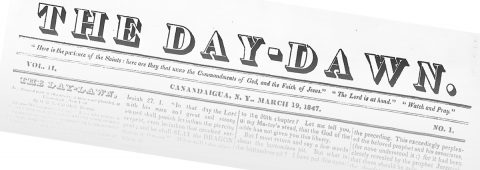
Last month, Part 1 of this series described the trauma Millerites experienced when Jesus did not return on October 22, 1844, and the views many developed to explain their disappointment. Part 2 examines the experience of Hiram Edson as described in his autobiographical manuscript.
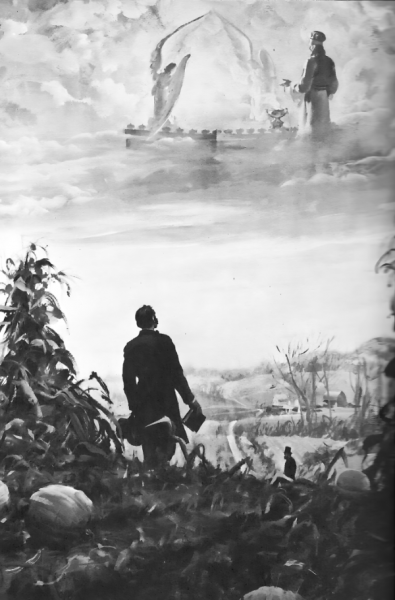
Cornfield Cleopas
Luke 24 tells the story of two of Christ’s disciples, Cleopas and his unnamed friend, who were returning to their home in Emmaus following the crucifixion of Jesus when the risen Christ appeared beside them, although they did not recognize Him. After listening to them express their disappointment at His death and subsequent disappearance from the tomb, Christ revealed to them all that the law and the prophets had predicted about His death and resurrection. During supper at the men’s home that evening, as Jesus was dividing the bread among them, they saw the nail scars in His hands and knew who He was, but He disappeared. Forgetting their supper, they returned to Jerusalem to share the good news of a resurrected Savior with the other disciples. As they ran, one of them said to the other, “When he talked with us along the road and explained the Scriptures to us, didn’t it warm our hearts?” (Luke 24:32, CEV). Suddenly, they experienced a paradigm shift in their understanding of the Old Testament prophecies concerning Christ that they had read many times before.
Drawing a modern parallel to that experience, one author emphasized that, just as Cleopas and his friend expected Christ to come as a king and conqueror of the Romans and not as a crucified Savior on a cross of shame, so Edson and his Millerite friends expected Him to come in glory to cleanse the earth by fire on October 22, 1844. And just as He opened those two disciples’ eyes to the true meaning of the Old Testament Scriptures relating to His mission on earth, His death at Calvary, and His resurrection, so He opened Edson’s and Crosier’s eyes to the Scriptures regarding His ministry in the Most Holy Place of the heavenly sanctuary beginning on October 22, 1844. In both cases, sincere seekers after truth received new light that led to a major shift in their understanding.1
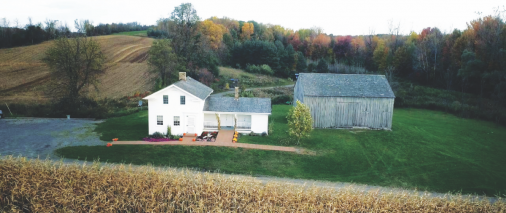
Yet while Cleopas and his companion trod a well-worn road to share this new understanding, Edson and Crosier cut through a field to encourage their disappointed friends on October 23, 1844.2 Why? Most writers have assumed that, in light of the verbal and physical abuse many Millerites had endured, the two men ducked across the field to avoid facing hostile neighbors. While this explanation might apply to the 24-year-old Crosier, it does not fit the profile of 38-year-old Edson, who (as described in Chapter 3 of my biography) exhibited boldness and courage rather than cowardice and fear in the face of physical threats. Edson may have felt embarrassed at not knowing how to explain to his neighbors why he had not ascended to heaven the previous day, but it is unlikely that he was afraid of them. One explanation would be simple geometry: Since country roads stretched for miles with few intersections, taking a shortcut through a field saved time. Another explanation would be meteorological: If it had rained recently, the dirt roads would have been quagmires deeply rutted with mud, whereas the cornfields, often planted with squash and pumpkins (as Native Americans had taught the early settlers), would have absorbed much of that rainfall and thus provided firmer ground for walking. In the 19th century, people often cut across fields when heavy rainstorms and blizzards made the dirt roads impassable.3
Edson’s autobiographical manuscript
While reading Edson’s handwritten manuscript is obviously of the utmost importance in understanding his view of what happened on October 23, this document has raised some questions among church historians. It is generally acknowledged that Edson wrote it, but since it is not dated, scholars are unsure as to when it was actually written: in 1844, in the mid-1850s, during the 1860s, or late in his life? Obviously, a document written in 1844 would be more reliable than one penned years later when Edson’s memory had faded. Chapter 11 (“Dark Days”) in my book explores this issue further.
Originally more than 200 pages long, the document included autobiographical material as well as prophetic speculation concerning the future of England.4 When Edson took it to the press in Battle Creek, requesting that it be published, the reading committee (including James White, J.N. Loughborough, Uriah Smith, and J.N. Andrews) agreed to print the autobiographical section but refused to publish the theological parts, viewing them as “a little too visionary [speculative].” Edson told Andrews, “But I have got some light [from God].” Andrews allegedly replied, “Then let me spoil your light.” Edson told them either to publish it all or publish nothing. The Review published none of it.5
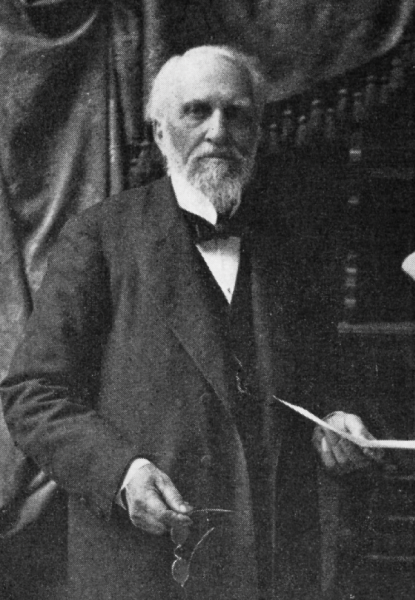
Subsequently, Edson gave the manuscript to Abby Lindsay, who edited it nine times, allegedly keeping a portion of it (about 33 pages), which she later shared with Arthur W. Spalding in June 1907.6 Three years later he quoted extensively from it in an article in the Youth’s Instructor.7 The rest of the manuscript was entrusted to John E. Place for safekeeping.8 After Edson’s death in 1882, Place presumably returned it to Edson’s daughter, Viah Ophelia Cross, who took it with her when she moved to Florida.9 Sometime later, Cross gave it to her daughter, Viah May Cross, of Pensacola, Florida.10 Cross loaned the manuscript to Herbert M. Kelley in 1921 and again in 1936, and Kelley subsequently mailed it to LeRoy Froom, who placed it in the Advent Source Collection at the General Conference in Takoma Park, Maryland.11 The manuscript was lost for nearly two decades until Mary Jane Mitchell, head librarian for the Adventist Theological Seminary in Takoma Park, rediscovered it in the 1950s.12 Over the ensuing decades, largely due to neglect, the extant manuscript shrank even further to only a dozen pages. But thanks to references to it in the writings of Froom, Spalding, Spicer, and others, it soon became more widely known among Adventist scholars.13
As related in Edson’s manuscript, on the morning of October 22, a few believers met in the Edson home to prepare for the Lord’s imminent return. When midnight came and Christ did not come, they wept together until dawn. The men then retired to the granary in the barn to kneel in prayer, asking God for light regarding their disappointment. Following this prayer session, most of the attendees went home, but Edson and Crosier decided to walk together to “encourage some of our brethren.” In Edson’s own words:
We started, and while passing through a large field I was stopped midway of the field. Heaven seemed open to my view, and I saw distinctly, and clearly, that instead of our High Priest coming out of the Most Holy of the heavenly sanctuary to come to this earth on the tenth day of the seventh month, at the end of the 2300 days, that he, for the first time entered on that day the second apartment of that sanctuary; and that he had a work to perform in the Most Holy before coming to this earth. That he came to the marriage at that time; in other words, to the Ancient of days, to receive a kingdom, dominion, and glory; and we must wait for his return from the wedding; and my mind was directed to the tenth ch[apter] of Rev[elation] where I could see the vision had spoken and did not lie.14
No doubt absorbed in his own thoughts, Crosier had continued walking across the field until he realized that his friend had stopped. Turning around, he inquired why Edson had paused in the middle of the field. Edson informed Crosier that the Lord was answering their morning prayers and that the sanctuary was not this earth, but was located in heaven.15
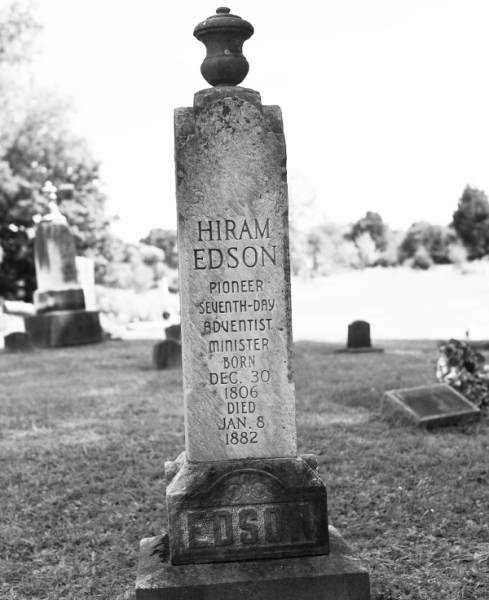
What exactly Edson “saw distinctly and clearly” in the cornfield has divided church historians, scholars, skeptics, and popular writers for nearly two centuries. Was it a revelation—a visible or audible intervention by God as in a vision? Was it inspiration—the Holy Spirit’s special urging of a messenger to speak or write with “fire in his bones”? Could it have been illumination—the Holy Spirit enlightening his mind with a great idea to share with his Adventist friends?16 Or did nothing of any significance occur in the cornfield?17
Next month, in Part 3, we will examine those writers who have advocated the first two views—that Edson received either a “vision” (a divine revelation) or a “flash of light” (a vivid impression) while crossing that cornfield.
_____________________________
Brian E. Strayer retired after 41 years of teaching and, in addition to writing, is a frequent speaker at camp meetings, weeks of prayer, conferences, and churches.
1 Clark Allan Floyd, «Who Was Cleopas?» Our Firm Foundation, Sept. 2013, pp. 4-6.
2 Although Edson, like the Gospel writer Luke, never mentioned the name of his cornfield companion, the consensus among Adventist historians and scholars has been that it was probably his close friend and houseguest Owen Russell Loomis Crosier.
3 For accounts of the bad roads that Adventist pioneers faced even in the second half of the 19th century, see Review, Feb. 12, 1862, p. 85; May 15, 1879, p. 159; April 18, 1882, p. 253; and Feb. 26, 1884, p. 140.
4 Herbert M. Kelley to L.E. Froom, Julio 1, 1936, ms. VT000273, no. 4, Center for Adventist Research, James White Library, Andrews University (hereafter cited as CAR, JWL, AU).
5 J.N. Loughborough to A.W. Spalding, Aug. 2, 1921, A.W. Spalding Correspondence, Coll. 10, Box 1, Fld. 2, CAR, JWL, AU; bracketed material mine.
6 Kelley to Froom, Julio 1, 1936, ms. VT000273, no. 4, CAR, JWL, AU.
7 Arthur W. Spalding, «Light on the Sanctuary: Adapted from the Manuscript of Hiram, Edson,» Youth’s Instructor, March 8, 1910, pp. 4-6.
8 Kelley to Froom, Julio 1, 1936, ms. VT000273, no. 4, CAR, JWL, AU.
9 Willian A. Spicer, Pioneer Days of the Advent Movement (Washington, DC: Review and Herald Pub. Assn., 1941), p. 66.
10 Affidavit signed by Viah Cross, Sept. 30, 1936, in Pensacola, Florida, ms. VT000273, CAR, JWL, AU.
11 Kelley to Froom, Julio 1, 1936, ms. VT000273, CAR, JWL, AU. There is some disagreement over whether Kelley mailed the Edson manuscript to Froom first in 1921 and later in 1936. Don Neufeld, speaking of his article, «The Disappointment According to Hiram Edson» in the Review, Oct. 22, 1970 (pp. 2-4), states that this exchange occurred in 1933.
12 L.E. Froom to Jim Nix, Nov. 3, 1971, in James R. Nix, «The Life and Work of Hiram Edson» (term paper for Church History 600—Problems in Church History, Seventh-day Adventist Theological Seminary, Andrews University, 1971), Appendix E, p. 159.
13 See, for example, A.W. Spalding to D.E. Robinson, Dec. 6, 1934, Spalding Correspondence, Coll. 10, Box 1, Fld. 2, CAR, JWL, AU; L.E. Froom to A.W. Spalding, Aug. 22, 1949; A.W. Spalding to L.E. Froom, Aug. 25, 1849, Spalding Correspondence, Coll. 10, Box 2, Fld. 2, CAR, JWL, AU; W.A. Spicer, Certainties of the Advent Movement (Washington, D.C.: Review and Herald Pub. Assn., 1929), pp. 169-170.
14 Hiram Edson, «Description of Hiram Edson’s Experience in the Cornfield on October 23, 1844 Plus Some Other Experiences in His Life Around the Same Time,» undated manuscript VT000272, CAR, JWL, AU.
15 Claiming that Edson had related to him the events of Oct. 22-23, 1844, as they were traveling together in 1852, Loughborough tells a much different story: That on Oct. 22, believers met in the Port Gibson schoolhouse, not in the Edson home; that they sang and prayed all night there, not returning to Edson’s farm until the next morning; and that while crossing the cornfield, they prayed three times by the corn shocks, after which Hiram received «light» about the heavenly sanctuary. As several historians have pointed out, however, Loughborough’s accounts of Adventist history prior to his conversion in 1852 are frequently unreliable. See J.N. Loughborough to A.W. Spalding, Aug. 2, 1921, Spalding Correspondence, Coll. 10, Box 1, Fld. 2, CAR, JWL, AU; A.W. Spalding to L.E. Froom, Aug. 25, 1949, Spalding Correspondence, Coll. 10, Box 2, Fld. 2, CAR, JWL, AU; Nix, «Edson,» p. 151; and Brian E. Strayer, J.N. Loughborough: The Last of the Adventist Pioneers (Hagerstown, MD: Review and Herald Pub. Assn., 2014), pp. 326-330, 341, 391-395, 405.
16 These three differing viewpoints are ably discussed in Alden Thompson, Inspiration: Hard Questions, Honest Answers, 2nd ed. (Gonzalez, FL: Energion Publications, 2016), p. 62.
17 This is the view advanced by such critics as Donald Barnhouse and Fernand Fisel, discussed as a fourth group.
El manuscrito autobiográfico de Hiram Edson - 2da. PARTE
Por Brian E. Strayer
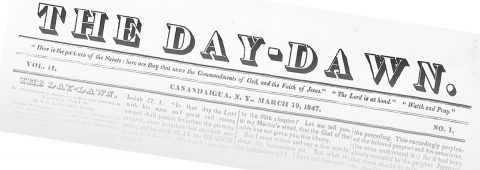
El mes pasado, la primera parte de esta serie describió el trauma que los milleritas experimentaron cuando Jesús no regresó el 22 de octubre de 1844, y los puntos de vista que muchos desarrollaron para explicar su decepción. La segunda parte examina la experiencia de Hiram Edson tal como se describe en su manuscrito autobiográfico.
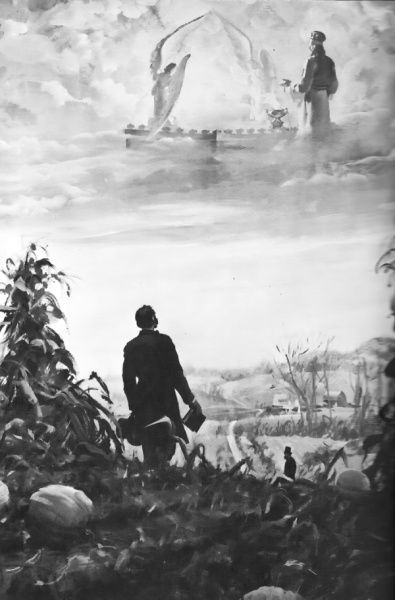
El campo de maíz de Cleofas
Lucas 24 cuenta la historia de dos de los discípulos de Cristo, Cleofas y su amigo anónimo, que regresaban a su hogar en Emaús después de la crucifixión de Jesús cuando Cristo resucitado apareció a su lado, aunque no lo reconocieron. Después de escucharlos expresar su decepción por su muerte y posterior desaparición del sepulcro, Cristo les reveló todo lo que la ley y los profetas habían predicho acerca de su muerte y resurrección. Esa noche, durante la cena en la casa de los hombres, mientras Jesús repartía el pan entre ellos, vieron las cicatrices de los clavos en sus manos y supieron quién era, pero desapareció. Olvidando su cena, regresaron a Jerusalén para compartir las buenas nuevas de un Salvador resucitado con los otros discípulos. Mientras corrían, uno de ellos le dijo al otro: «Cuando hablaba con nosotros por el camino y nos explicaba las Escrituras, ¿no nos ardía el corazón?» (Lucas 24:32). De repente, experimentaron un cambio de paradigma en su comprensión de las profecías del Antiguo Testamento concernientes a Cristo que habían leído muchas veces antes.
Trazando un paralelo moderno a esa experiencia, un autor enfatizó que, así como Cleofas y su amigo esperaban que Cristo viniera como rey y conquistador de los romanos y no como un Salvador crucificado en una vergonzosa cruz, así Edson y sus amigos milleritas esperaban que él viniera en gloria para limpiar la tierra con fuego el 22 de octubre. 1844. Y así como abrió los ojos de esos dos discípulos al verdadero significado de las Escrituras del Antiguo Testamento relacionadas con su misión en la tierra, su muerte en el Calvario y su resurrección, así también abrió los ojos de Edson y Crosier a las Escrituras con respecto a su ministerio en el Lugar Santísimo del santuario celestial a partir del 22 de octubre, 1844. En ambos casos, los buscadores sinceros de la verdad recibieron una nueva luz que condujo a un cambio importante en su comprensión.1
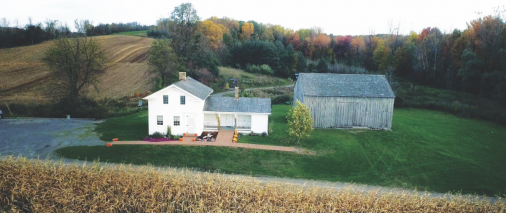
Sin embargo, mientras Cleofas y su compañero recorrían un camino trillado para compartir ese nuevo entendimiento, el 23 de octubre de 1844, Edson y Crosier atravesaron un campo para animar a sus amigos decepcionados.2 ¿Por qué? La mayoría de los escritores han asumido que, a la luz del abuso verbal y físico que muchos milleritas habían soportado, los dos hombres se agacharon por el campo para evitar enfrentarse a vecinos hostiles. Si bien esa explicación podría aplicarse a Crosier, de 24 años, no se ajusta al perfil de Edson, de 38 años, quien (como se describe en el capítulo 3 de mi biografía) exhibió audacia y valor en lugar de cobardía y miedo frente a las amenazas físicas. Es posible que Edson se sintiera avergonzado por no saber cómo explicar a sus vecinos por qué no había ascendido al cielo el día anterior, pero es poco probable que les tuviera miedo. Una explicación sería la geometría simple: dado que los caminos rurales se extendían por millas con pocas intersecciones, tomar un atajo a través de un campo ahorraba tiempo. Otra explicación sería meteorológica: si hubiera llovido recientemente, los caminos de tierra habrían sido lodazales, mientras que los campos de maíz, a menudo plantados con calabazas (como los nativos americanos habían enseñado a los primeros colonos), habrían absorbido gran parte de esa lluvia y, por lo tanto, habrían proporcionado un terreno más firme para caminar. En el siglo XIX, la gente a menudo atravesaba los campos cuando las fuertes tormentas y ventiscas hacían que los caminos de tierra fueran intransitables.3
Manuscrito autobiográfico de Edson
Si bien la lectura del manuscrito de Edson es obviamente de suma importancia para comprender su punto de vista de lo que sucedió el 23 de octubre, ese documento ha planteado algunas preguntas entre los historiadores de la iglesia. Generalmente se reconoce que Edson lo escribió pero, dado que no está fechado, los eruditos no están seguros de cuándo fue realmente escrito: ¿en 1844, a mediados de la década de 1850, durante la década de 1860 o al final de su vida? Obviamente, un documento escrito en 1844 sería más confiable que uno escrito años después, cuando la memoria de Edson se había desvanecido. El capítulo 11 («Días oscuros») de mi libro explora ese tema más a fondo.
Originalmente de más de 200 páginas, el documento incluía material autobiográfico, así como especulaciones proféticas sobre el futuro de Inglaterra.4 Cuando Edson lo llevó a la imprenta en Battle Creek, solicitando que se publicara, el comité de lectura (incluyendo a James White, J.N. Loughborough, Uriah Smith y J.N. Andrews) acordó imprimir la sección autobiográfica, pero se negó a publicar las partes teológicas, considerándolas «un poco demasiado visionarias [especulativas]». Edson le dijo a Andrews: «Pero tengo algo de luz [de Dios]». Andrews supuestamente respondió: «Entonces déjame estropear tu luz». Edson les dijo que lo publicaran todo o que no publicaran nada. La Review no publicó nada de eso.5
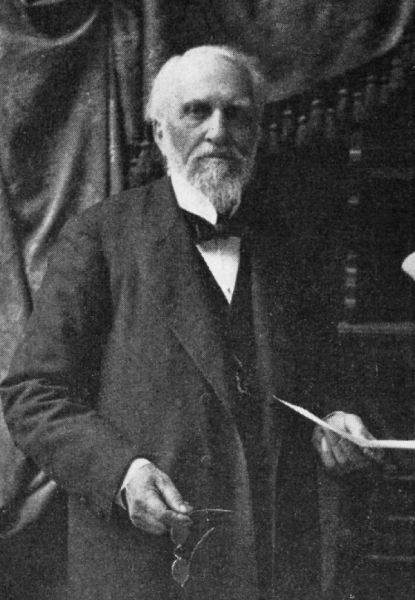
Posteriormente, Edson entregó el manuscrito a Abby Lindsay, quien lo editó nueve veces, supuestamente conservando una parte del mismo (unas 33 páginas), que más tarde compartió con Arthur W. Spalding en junio de 1907.6 Tres años más tarde lo citó extensamente en un artículo en la revista Youth’s Instructor.7 El resto del manuscrito fue confiado a John E. Place para su custodia.8 Después de la muerte de Edson en 1882, Place presumiblemente se lo devolvió a la hija de Edson, Viah Ophelia Cross, quien se lo llevó consigo cuando se mudó a Florida.9 Algún tiempo después, Cross se lo dio a su hija, Viah May Cross, de Pensacola, Florida.10 Cross prestó el manuscrito a Herbert M. Kelley en 1921 y nuevamente en 1936, y Kelley posteriormente lo envió por correo a LeRoy Froom, quien lo colocó en la Advent Source Collection en la Conferencia General en Takoma Park, Maryland.11 El manuscrito estuvo perdido durante casi dos décadas hasta que Mary Jane Mitchell, bibliotecaria principal del Seminario Teológico Adventista en Takoma Park, lo redescubrió en la década de 1950.12 A lo largo de las décadas siguientes, en gran parte debido al abandono, el manuscrito existente se redujo aún más a solo una docena de páginas. Pero gracias a las referencias en los escritos de Froom, Spalding, Spicer y otros, pronto se hizo más conocido entre los eruditos adventistas.13
Como se relata en el manuscrito de Edson, en la mañana del 22 de octubre, algunos creyentes se reunieron en la casa de Edson para prepararse para el inminente regreso del Señor. Cuando llegó la medianoche y Cristo no vino, lloraron juntos hasta el amanecer. Luego, los hombres se retiraron al granero para arrodillarse en oración, pidiendo a Dios luz con respecto a su decepción. Después de esa sesión de oración, la mayoría de los asistentes se fueron a casa, pero Edson y Crosier decidieron ir juntos para «animar a algunos de nuestros hermanos». En las propias palabras de Edson:
Partimos y, al pasar por un gran campo. me detuve a mitad del campo. El cielo parecía abierto a mi vista y vi distinta y claramente que en lugar de que nuestro Sumo Sacerdote saliera del Santísimo del santuario celestial para venir a esta tierra el décimo día del séptimo mes, al final de los 2300 días, él, por primera vez, entró en ese día en el segundo apartamento de ese santuario; y que tenía una obra que realizar en el Santísimo antes de venir a esta tierra. Que él llegó al matrimonio en ese momento; en otras palabras, al Anciano de días, para recibir un reino, dominio y gloria; y hay que esperar su regreso de la boda; y mi mente se dirigió al décimo capítulo de Apocalipsis, donde pude ver que la visión había hablado y no mentía.14
Sin duda absorto en sus pensamientos, Crosier había seguido caminando por el campo hasta que se dio cuenta de que su amigo se había detenido. Volviéndose, preguntó por qué Edson se había detenido en medio del campo. Edson le informó a Crosier que el Señor estaba respondiendo a sus oraciones matutinas y que el santuario no era esta tierra, sino que estaba ubicado en el cielo.15
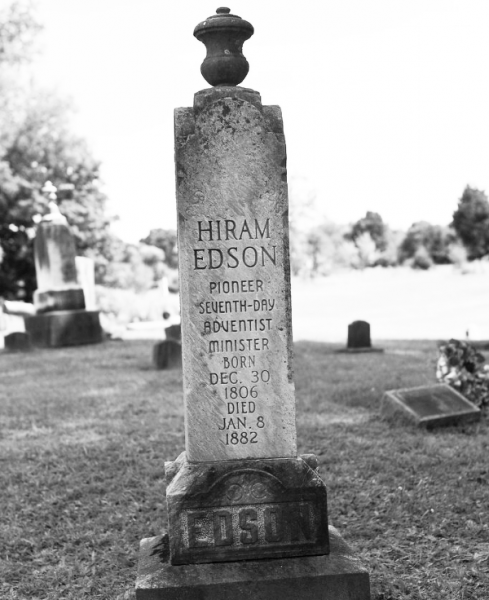
Lo que exactamente Edson «vio clara y distintamente» en el campo de maíz ha dividido a historiadores de la iglesia, eruditos, escépticos y escritores populares durante casi dos siglos. ¿Fue una revelación, una intervención visible o audible de Dios como en una visión? ¿Fue inspiración, el exhorto especial del Espíritu Santo a un mensajero a hablar o escribir con «fuego en sus huesos»? ¿Podría haber sido iluminación, el Espíritu Santo iluminando su mente con una gran idea para compartir con sus amigos adventistas?16 ¿O es que no ocurrió nada de importancia en esa milpa?17
El próximo mes, en la Parte 3, examinaremos a aquellos escritores que han defendido los dos primeros puntos de vista: que Edson recibió una «visión» (una revelación divina) o un «destello de luz» (una impresión vívida) mientras cruzaba ese campo de maíz.
_____________________________
Brian E. Strayer se jubiló después de 41 años de enseñanza y, además de escribir, es un orador frecuente en reuniones de campamento, semanas de oración, conferencias e iglesias.
1 Clark Allan Floyd, «Who Was Cleopas?» Our Firm Foundation, Sept. 2013, pp. 4-6.
2 Although Edson, like the Gospel writer Luke, never mentioned the name of his cornfield companion, the consensus among Adventist historians and scholars has been that it was probably his close friend and houseguest Owen Russell Loomis Crosier.
3 For accounts of the bad roads that Adventist pioneers faced even in the second half of the 19th century, see Review, Feb. 12, 1862, p. 85; May 15, 1879, p. 159; April 18, 1882, p. 253; and Feb. 26, 1884, p. 140.
4 Herbert M. Kelley to L.E. Froom, Julio 1, 1936, ms. VT000273, no. 4, Center for Adventist Research, James White Library, Andrews University (hereafter cited as CAR, JWL, AU).
5 J.N. Loughborough to A.W. Spalding, Aug. 2, 1921, A.W. Spalding Correspondence, Coll. 10, Box 1, Fld. 2, CAR, JWL, AU; bracketed material mine.
6 Kelley to Froom, Julio 1, 1936, ms. VT000273, no. 4, CAR, JWL, AU.
7 Arthur W. Spalding, «Light on the Sanctuary: Adapted from the Manuscript of Hiram, Edson,» Youth’s Instructor, March 8, 1910, pp. 4-6.
8 Kelley to Froom, Julio 1, 1936, ms. VT000273, no. 4, CAR, JWL, AU.
9 Willian A. Spicer, Pioneer Days of the Advent Movement (Washington, DC: Review and Herald Pub. Assn., 1941), p. 66.
10 Affidavit signed by Viah Cross, Sept. 30, 1936, in Pensacola, Florida, ms. VT000273, CAR, JWL, AU.
11 Kelley to Froom, Julio 1, 1936, ms. VT000273, CAR, JWL, AU. There is some disagreement over whether Kelley mailed the Edson manuscript to Froom first in 1921 and later in 1936. Don Neufeld, speaking of his article, «The Disappointment According to Hiram Edson» in the Review, Oct. 22, 1970 (pp. 2-4), states that this exchange occurred in 1933.
12 L.E. Froom to Jim Nix, Nov. 3, 1971, in James R. Nix, «The Life and Work of Hiram Edson» (term paper for Church History 600—Problems in Church History, Seventh-day Adventist Theological Seminary, Andrews University, 1971), Appendix E, p. 159.
13 See, for example, A.W. Spalding to D.E. Robinson, Dec. 6, 1934, Spalding Correspondence, Coll. 10, Box 1, Fld. 2, CAR, JWL, AU; L.E. Froom to A.W. Spalding, Aug. 22, 1949; A.W. Spalding to L.E. Froom, Aug. 25, 1849, Spalding Correspondence, Coll. 10, Box 2, Fld. 2, CAR, JWL, AU; W.A. Spicer, Certainties of the Advent Movement (Washington, D.C.: Review and Herald Pub. Assn., 1929), pp. 169-170.
14 Hiram Edson, «Description of Hiram Edson’s Experience in the Cornfield on October 23, 1844 Plus Some Other Experiences in His Life Around the Same Time,» undated manuscript VT000272, CAR, JWL, AU.
15 Claiming that Edson had related to him the events of Oct. 22-23, 1844, as they were traveling together in 1852, Loughborough tells a much different story: That on Oct. 22, believers met in the Port Gibson schoolhouse, not in the Edson home; that they sang and prayed all night there, not returning to Edson’s farm until the next morning; and that while crossing the cornfield, they prayed three times by the corn shocks, after which Hiram received «light» about the heavenly sanctuary. As several historians have pointed out, however, Loughborough’s accounts of Adventist history prior to his conversion in 1852 are frequently unreliable. See J.N. Loughborough to A.W. Spalding, Aug. 2, 1921, Spalding Correspondence, Coll. 10, Box 1, Fld. 2, CAR, JWL, AU; A.W. Spalding to L.E. Froom, Aug. 25, 1949, Spalding Correspondence, Coll. 10, Box 2, Fld. 2, CAR, JWL, AU; Nix, «Edson,» p. 151; and Brian E. Strayer, J.N. Loughborough: The Last of the Adventist Pioneers (Hagerstown, MD: Review and Herald Pub. Assn., 2014), pp. 326-330, 341, 391-395, 405.
16 These three differing viewpoints are ably discussed in Alden Thompson, Inspiration: Hard Questions, Honest Answers, 2nd ed. (Gonzalez, FL: Energion Publications, 2016), p. 62.
17 This is the view advanced by such critics as Donald Barnhouse and Fernand Fisel, discussed as a fourth group.





